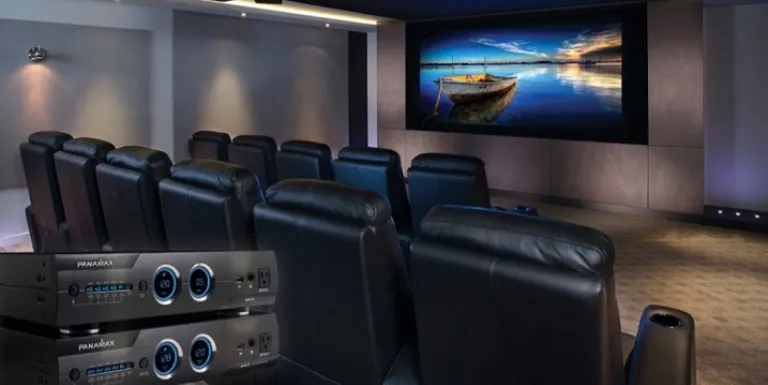In the age of high-definition movies immersive sound scapes and cutting-edge home entertainment systems, the desire for a cinematic experience in the comfort of one’s home has become more prevalent than ever. Whether you’re a casual viewer or a dedicated audiophile, the quality of your home theater setup can significantly impact your overall viewing experience. However, as you invest in top-notch audio-visual equipment, ensuring that they are well-protected and optimized becomes crucial. This is where a home theatre power manager steps in, offering a blend of protection, performance enhancement, and energy efficiency.
What is a Home Theatre Power Manager?
A home theatre power manager is an essential device designed to regulate and distribute power to your home entertainment system. It goes beyond a simple power strip, offering a host of features that protect your equipment from power surges, voltage fluctuations, and electrical noise. These devices are specifically engineered to deliver clean and stable power, ensuring that your expensive AV components, such as receivers, speakers, subwoofers, and projectors, operate at their best.
By managing the power supply, a home theatre power manager minimizes the risk of damage due to unpredictable electrical currents. It not only safeguards your equipment but also enhances their performance, allowing you to enjoy better sound quality, sharper visuals, and a more reliable entertainment system overall.
Why Do You Need a Home Theatre Power Manager?
With the increasing complexity and sophistication of home theater setups, the need for a reliable power management solution has never been greater. Fluctuations in voltage and electrical noise can have detrimental effects on sensitive electronic components, leading to reduced performance, potential malfunctions, and even permanent damage. A home theatre power manager acts as a barrier, filtering out unwanted noise and stabilizing the power supply to prevent such issues.
Moreover, the benefits of a power manager extend beyond protection. By delivering clean and consistent power, these devices can improve the overall efficiency of your home theater system. This results in enhanced audio clarity, improved video quality, and a longer lifespan for your equipment. In essence, a home theatre power manager is an investment in the longevity and performance of your entertainment system.
Key Features of a Home Theatre Power Manager
1. Surge Protection: Safeguarding Your Investment
One of the primary functions of a home theatre power manager is to protect your equipment from power surges. A power surge occurs when there is a sudden increase in voltage, which can cause significant damage to electronic devices. Surges can be caused by various factors, including lightning strikes, power outages, and even the cycling of large appliances.
A power manager acts as a surge protector by detecting these voltage spikes and diverting the excess energy away from your home theater components. This prevents the surge from reaching your equipment, thereby safeguarding your investment and ensuring that your devices continue to function properly.
2. Voltage Regulation: Ensuring Stable Power Supply
Voltage fluctuations are another common issue that can affect the performance of your home theater system. When the voltage is too high or too low, it can cause your equipment to malfunction or operate inefficiently. For instance, low voltage can lead to reduced sound quality and diminished video clarity, while high voltage can cause overheating and damage to sensitive components.
A home theatre power manager addresses this issue by regulating the voltage that reaches your devices. It ensures that your equipment receives a stable and consistent power supply, regardless of fluctuations in the electrical grid. This not only improves performance but also extends the lifespan of your devices by preventing stress on their internal components.
3. Power Conditioning: Filtering Out Electrical Noise
Electrical noise, or interference, is an often-overlooked factor that can degrade the performance of your home theater system. This noise can originate from various sources, such as household appliances, wireless devices, and even the power lines themselves. When electrical noise infiltrates your power supply, it can introduce distortions in the audio and video signals, leading to a less enjoyable viewing experience.
A home theatre power manager incorporates power conditioning technology to filter out this unwanted noise. By delivering clean and pure power to your equipment, it eliminates distortions and ensures that your audio and video signals remain clear and true to their original quality. This results in crisper sound, sharper visuals, and a more immersive entertainment experience.
4. Power Sequencing: Preventing Overload and Extending Lifespan
Power sequencing is another valuable feature offered by many home theatre power managers. This function allows you to control the order in which your devices power on and off, preventing power surges and overloads that can occur when multiple components are turned on simultaneously.
For example, when you power on your home theater system, the power manager can be programmed to turn on the amplifier first, followed by the AV receiver, and then the speakers. This staggered approach reduces the initial load on the electrical circuit and minimizes the risk of damaging your equipment. Additionally, power sequencing helps to extend the lifespan of your devices by reducing wear and tear on their power supplies.
5. Energy Efficiency: Reducing Power Consumption
In today’s environmentally conscious world, energy efficiency is a key consideration for many consumers. A home theatre power manager can contribute to energy savings by optimizing the power consumption of your entertainment system. It ensures that each device receives only the amount of power it needs, reducing overall energy usage and lowering your electricity bills.
Furthermore, some power managers are equipped with smart technology that automatically powers down devices when they are not in use. This feature, known as “standby power management,” helps to minimize energy waste and further enhances the efficiency of your home theater system.
How to Choose the Right Home Theatre Power Manager
1. Assess Your Home Theater Setup
Before selecting a home theatre power manager, it’s important to assess your current setup and determine your specific needs. Consider the number of devices in your system, their power requirements, and any existing issues with voltage fluctuations or electrical noise. This will help you choose a power manager that is appropriately sized and equipped to handle your setup.
For instance, if you have a large home theater with multiple high-powered components, you may need a power manager with a higher wattage rating and more outlets. On the other hand, if your system is relatively simple, a basic power manager with surge protection and voltage regulation may suffice.
2. Look for Key Features
When comparing different power managers, be sure to look for the key features discussed earlier in this article. Surge protection, voltage regulation, power conditioning, power sequencing, and energy efficiency are all important considerations. Additionally, some power managers offer advanced features such as remote control, programmable settings, and monitoring displays that provide real-time information about your power usage.
It’s also worth considering the build quality and durability of the power manager. Look for devices made from high-quality materials with robust internal components, as these will offer better protection and longer-lasting performance.
3. Consider Your Budget
Home theatre power managers are available at a wide range of price points, from affordable models to high-end devices with advanced features. While it’s tempting to opt for the most expensive model, it’s important to choose a power manager that fits your budget and meets your specific needs.
Keep in mind that a higher price doesn’t always equate to better performance. Focus on finding a power manager that offers the features you need at a price you can afford. Consider the long-term benefits of investing in a quality power manager, such as improved performance, extended equipment lifespan, and potential energy savings.
4. Read Reviews and Seek Recommendations
Before making a purchase, take the time to read reviews from other consumers and seek recommendations from trusted sources. User reviews can provide valuable insights into the performance and reliability of different power managers, helping you make an informed decision.
Additionally, consider reaching out to friends, family members, or online communities who have experience with home theater setups. They may be able to offer advice and recommendations based on their own experiences, guiding you toward a power manager that will best suit your needs.
Installing and Using Your Home Theatre Power Manager
1. Installation Tips
Installing a home theatre power manager is generally straightforward, but there are a few tips to keep in mind to ensure optimal performance. Start by choosing a suitable location for the power manager, ideally near your AV components and within easy reach of a power outlet.
Next, connect your devices to the power manager according to the manufacturer’s instructions. Be sure to plug each device into the appropriate outlet, as some power managers have designated outlets for high-power devices, such as amplifiers, and low-power devices, such as DVD players.
Once everything is connected, turn on the power manager and test your system to ensure that all components are functioning properly. If your power manager offers programmable settings or power sequencing, take the time to configure these features to match your preferences.
2. Regular Maintenance
To keep your home theatre power manager in top condition, it’s important to perform regular maintenance. This includes checking the device for any signs of wear or damage, such as frayed cords or loose connections. If you notice any issues, address them promptly to prevent potential problems.
Additionally, keep the power manager clean and free of dust, which can accumulate over time and affect its performance. Use a soft, dry cloth to wipe down the exterior, and avoid using harsh chemicals or abrasive materials that could damage the device.
3. Troubleshooting Common Issues
While home theatre power managers are designed to be reliable and user-friendly, you may occasionally encounter issues. Common problems include power outages, tripped circuit breakers, or unexpected shutdowns of your home theater system.
If you experience any of these issues, start by checking the power manager’s indicators or display for any error messages. These can often provide clues as to the cause of the problem. If necessary, refer to the manufacturer’s troubleshooting guide or contact customer support for assistance.
In many cases, issues can be resolved by resetting the power manager or adjusting the settings. However, if the problem persists, it may be necessary to have the device inspected or replaced.
Conclusion
A home theatre power manager is more than just a convenience—it’s an essential component of any serious home entertainment setup. By protecting your equipment from power surges, regulating voltage, filtering out electrical noise, and optimizing power consumption, a power manager ensures that your home theater system performs at its best.
Investing in a quality power manager not only enhances your viewing and listening experience but also extends the lifespan of your valuable equipment, providing peace of mind and long-term savings. Whether you’re a movie enthusiast, a music lover, or simply someone who values a reliable entertainment system, a home theatre power manager is a wise addition to your setup.







